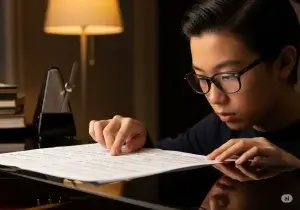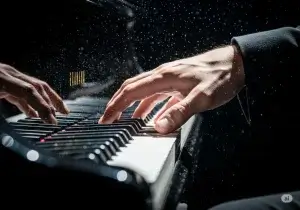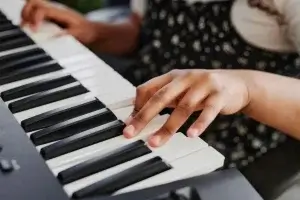Reach your full potential at the piano by mastering the fundamentals. A solid technical foundation is essential to confident, expressive playing, whether you’re a beginner or an advanced pianist. At Silver Maple Piano Studio, we focus on classical piano technique to help you become a well-rounded, capable pianist. With personalized instruction and a supportive learning environment, we help you build your skills, so that you can play with ease and unlock your full musical potential.
Why Master the Fundamentals?
Developing proper piano technique leads to faster progress, improved musicality, and longevity at the piano. When you master the fundamental techniques, you:
- Learn faster and avoid frustration: Proper technique enables you to learn new pieces in less time, saving you hours of practice. You won’t struggle with the physical demands of complex musical passages, allowing you to play through pieces with ease.
- Play with confidence and expression: With a strong technical foundation, you can express yourself freely at the keyboard. Proper technique eliminates tension, allowing for a richer tone, smoother playing, and the confidence to incorporate greater musicality and deeper expression into the pieces you play.
- Enjoy lifelong piano success: Fundamentals are for life. Building correct habits now means you’ll avoid injury, conquer advanced repertoire down the road, and continue improving for years to come. It’s an investment in your musical journey that always pays off.
Below, we’ll explore the core elements of classical piano technique and how Silver Maple Piano Studio helps you master each one with ease and expertise.
Aspects of Technique
Proper posture
First, sit up straight. You don’t have to be completely rigid; just sit up tall on the bench. Your shoulders should be relaxed – this is an important point. Why? If you raise your shoulders while playing, the tension will be carried down your arm. You should feel generally balanced, and you want your body to feel relaxed but “prepared,” not stiff or tense.
Wrist bounce
A basic technique for detached notes, octaves and chords is the wrist bounce. You prepare the motion by raising your wrist slightly and letting your hand dangle; this will help create momentum. Then, you let your arm fall, with your finger(s) falling “through” the key (more on this later). When your finger strikes the key, your wrist will naturally fall to a neutral position and then ricochet back up, like bouncing on a trampoline. This entire motion should feel effortless, whether you are playing loud or soft, fast or slow.
Relaxed fingers
Don’t curl or flatten the fingers; keep them in a loose curve. The weight of your arm will provide the power needed to strike the key, so you don’t have to tense up the fingers to play. All the fingers do is “flap down” from the knuckle as you sink into key with the weight of your arm. This small “flapping” motion is what creates finger independence. Never attempt to lift a finger off the key; just let it release off the key – that way, you’re letting the fingers move back to a neutral position. Pulling fingers upward will lead to injury.
Falling “through” the key
This has to do with the arm weight I mentioned earlier. Don’t dig into the key with your finger; let the weight of your arm do the work. Imagine the keys as being water or foam. Imagine that you’re letting your hand drop through the key, to the floor. Once you’ve reached the bottom of the key, just let the finger and hand “hang out,” relaxed while still keeping the key depressed. Again, don’t dig into the key; your arm, and even your finger, is heavier than the key, so no extra effort is required here.
Forearm rotation
For connected notes (legato), forearm rotation is essential. Think of turning a doorknob; this motion will help you rotate the forearm, hand and finger together (more on this in the next point) towards the note you want to play. By calibrating the degree of rotation over the course of several notes, you can easily play the notes legato.
Using the arm, hand, and fingers “as one”
The arm, hand, and fingers should move as a single unit. This does not mean that you keep all of them stiffly aligned; rather, your arm should always be “behind” the finger that is playing. For example, if you want to move from finger 1 to finger 5, you will rotate your arm, hand and finger all together (as one) towards finger five to press the key. This enables an ease of motion, and you are working with your anatomy; you are not fighting against your body.
Wrist circles
This is related to forearm rotation. The idea is that we don’t just do a see-saw motion with the forearm; there is something of an arc or sweep happening as well, hence the wrist circle. When the notes are moving towards finger 5, you make a sweeping motion, like a shallow bowl, towards finger 5. When the notes are moving towards finger 1, you make an arc motion, like a rainbow, towards finger 1. This allows for a fluid, continuous movement as you play several notes in succession.
Benefits of Technique
Longevity
Simply put, if you play with proper technique, you’ll be able to play piano for a long time. I don’t just mean for two hours at a time; I mean that you’ll be able to play for decades. By avoiding injury, your arm getting “tired,” or any other discomfort, you will be using your body optimally at the piano, not fighting against it. Playing with correct technique sets you up for decades of pleasurable and easy playing.
Stamina
Long, emotionally demanding and/or technically demanding pieces require a certain level of energy – this is straightforward enough. But you must play with proper technique if you want to actually reach the end of any of these pieces. Proper technique allows you to NOT put physical effort into playing; it feels like floating. As such, it becomes relatively easy to sustain “stamina” throughout a demanding performance.
Power
You will actually be able to play louder if you incorporate proper technique. By using arm weight to strike a key, you will be able to get a louder tone without digging into the keys with your fingers and hurting yourself. The use of arm weight also enables your fingers to remain stable (rather than collapsing) when you strike the keys, ensuring precision along with power.
Control
Technique gives you control via fluid, continuous gestures; your arm, hand and fingers being aligned; using arm weight; sinking into the key; and a feeling of “floating” rather than digging. All of these aspects of technique promote stability and control at the piano. You will be able to precisely calibrate dynamics, play fast passages with an even rhythm and tone, and strike the keys with exactly the articulation you intend (whether staccato, legato, or accented).
Expression
This is the most important thing. While there are many advantages to technique, it is, ultimately, a means to an end: technique is the vehicle by which you achieve musical expression. Every expressive choice at the piano has a physical counterpart in terms of gesture and keystroke. The forearm rotation creates a smooth, connected, singing line; the wrist bounce enables the sounding out of triumphant, majestic chords; the wrist circle gives you precision in rhythm and tone when you play. Once you have incorporated proper technique into your playing, it becomes much easier to play rubato (slight variations in tempo, which adds a “human,” singing quality to the melody), and to play at different speeds and volumes. You can make the music come alive in a way that just feels so much easier and natural than if you were playing without technique. It’s no longer an uphill battle; it actually feels good to play, and you can now give yourself over to the emotions of the piece, creating a truly expressive performance.
The Silver Maple Advantage
Choosing the right piano teacher makes all the difference in your learning experience. At Silver Maple Piano Studio, I offer a student-centric approach; your success is our priority, in every lesson. When you study piano at Silver Maple, you benefit from:
- Personalized instruction – Lessons are tailored to your goals and learning style. Whether you’re preparing for an exam or playing for fun, we adjust our approach to help you progress faster.
- Experienced instructor – Learn from a qualified, classically-trained teacher. I’ll help you avoid bad habits and refine your technique so that you can play piano with ease.
- Stress-free learning environment – No judgment, no pressure. Mistakes are no big deal, just steps toward growth. I strive to cultivate a supportive environment where you feel comfortable asking question and trying new things.
- Fast progress and results – A structured curriculum ensures that each lesson builds on the last. Success is a great motivator, and you’ll see noticeable improvements in your playing over time.
Ready to transform your piano playing with expert guidance? Let Silver Maple Piano Studio help you master the fundamentals and achieve the musical growth you’ve been dreaming of. Book a Free Trial Lesson Today and take the first step toward becoming the confident, skilled pianist you’ve always wanted to be.






